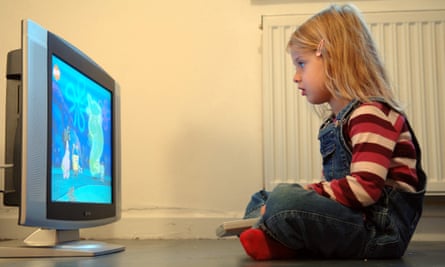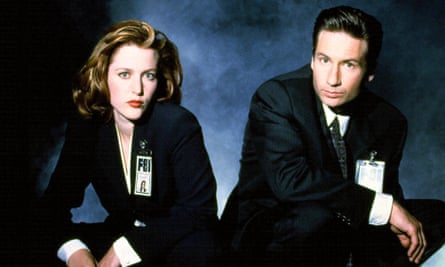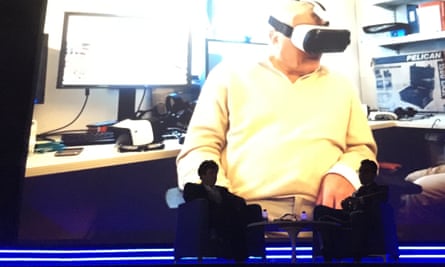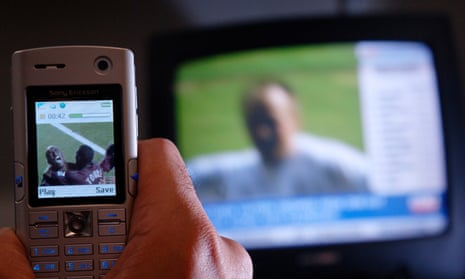If you had a pound for every time an executive said “this is a golden age of television” at the Mipcom industry conference in Cannes, you could probably finance the next series of House of Cards yourself.
Beyond the cliches, though, the annual event offers a snapshot of the uneasy relationship between the TV and tech industries, and what it might mean for our viewing habits. Broadcasters were optimistic.
“For us as an industry, and particularly for us as content creators, we have never had it so good,” said Sophie Turner Laing, boss of production group Endemol Shine. “Maybe TV was a little late in coming to the digital party, but let’s face it, it wouldn’t be a good party without us.”
Tech firms, even those that pride themselves on being friendly partners to the TV business, delivered warnings.
“TV is facing some of its greatest challenges,” said Twitter executive Dan Biddle. “How the industry reacts to those challenges in the next few years will affect how the audience experiences TV for many, many years to come.”
Here are the key themes that were bubbling throughout the conference.
Social TV battle shapes up

Facebook and Twitter are battling to be the TV industry’s best digital watercooler – the place where viewers chat about the shows they’re watching. Yet their mobile apps are increasingly popular places to watch video too.
“Video is exploding,” said Facebook’s Nicola Mendelsohn in a keynote speech. “What we see on Facebook today is that there are over 4bn video views every day, and 75% of them are on mobile.”
Twitter had its own stats to announce. “370 years of video are now watched every day on Twitter,” said its entertainment partnerships boss, Fred Graver, adding that 90% of that viewing happens on mobile devices.
Neither company wants to become a broadcaster, although Twitter has a community of creators making original six-second clips on its Vine app, and broadcasting live video on its Periscope app.
Instead, the social networks are competing to prove to television companies that they can help boost audiences of their TV shows, from Facebook adding features like talent-show voting and audience polls using hashtags, to Twitter creating timelines for individual shows curating popular tweets from viewers and cast members.
Their pitches often mirror one another. “We know we can connect massive audiences in front of our TV sets in those magic hours of primetime,” said Twitter’s Anjali Midha. “We see Facebook usage peaks at exactly the same time TV viewing peaks in every country in the world,” said Facebook’s Mendelsohn.
TV executives like Turner Laing flew the flag for TV. “By itself, social media doesn’t get close to the bond between a programme and a viewer who’s settled down on a sofa after a long day at the office,” she said.
Yet broadcasters were warned not to assume old viewing habits apply for younger viewers. “The way younger people communicate and socialise is very different,” said Sam Toles of online video service Vimeo.
“Their socialisation is sharing and liking content on social media. And for folks in my generation it may seem lonely, but it is honestly the way people in that generation engage.”
Children’s TV upheaval

The idea of children as “digital natives” keener on watching video and playing games on tablets and smartphones than watching the television in the corner of the living room has dominated conferences like Mipcom in recent years.
The traditional children’s channels continue to say that this is a positive trend for their shows and characters rather than a problem: even if their live viewing figures are falling, they claim they are still reaching kids beyond the TV.
“I just view it as the more screens kids have, the more they need stuff to watch on those screens,” said Dan Schneider, who’s created many of Nickelodeon’s most popular shows. “Television is pictures and sound, and if they’re watching it on a screen, and they’re watching our stuff, we’re winning.”
But are they? As children spend more time on tablets and smartphones, the content of a company like Nickelodeon becomes just another app, competing with mobile games and YouTube in particular.
In August 2015, five of the 10 most popular channels on YouTube were aimed at children, with Little Baby Bum, The Diamond Minecart, Baby Big Mouth, Fun Toyz Collector and Masha and the Bear generating 1.8 billion video views that month from their animation, Minecraft videos and toy-unboxing videos.
Research firm Dubit revealed that when children were asked for their favourite brands, Minecraft, Angry Birds and Candy Crush Saga were among the most popular, alongside toy+TV brands like Lego and Barbie.
Where children’s TV channels like Nickelodeon, Cartoon Network and CBBC used to compete against one another, now they must adapt to competing against Minecraft, Little Baby Bum, Candy Crush Saga and The Diamond Minecart.
The comeback kids (and aliens)

A common theme at Mipcom was the difficulty of “cutting through the clutter” of shows, channels, social networks and apps – whether a new show is aimed at children or adults. This is why remaking old shows is such a popular strategy in 2015.
“In all the clutter, it’s difficult to break through and get noticed. An iconic character can do that better than an original character,” said Allen Bohbot of 41 Entertainment, which has already revived Pac-Man and King Kong as children’s shows, with plans to bring back Tarzan and Jane next.
“An extensive show library gives people a chance to rediscover an old show and create a new appetite,” said Dana Walden of Fox Television Group. “If it feels like the story is not fully told, we’re definitely gonna move forward with those projects.”
Her company has done that with sci-fi series The X-Files, which is returning with six new episodes of Mulder and Scully, with the original actors and writers all involved.
An excellent first episode that premiered in Cannes suggests that the reboot has worked.
Science and factual on a roll
X-Files creator Chris Carter stressed that science is crucial to the X-Files reboot: “If it weren’t for the science, this would be just another show about the paranormal,” he said. There was wider optimism about attracting large audiences to science and large-scale documentaries in 2015.
“It’s an important time for big science to be heard,” said Liz Dolan of National Geographic, which is filming new series about scientific breakthroughs and the potential future colonisation of Mars, as well as Morgan Freeman’s The Story of God.
Other producers said that new technology is helping them tell better stories about science and the natural world, from the drone cameras and military-grade thermal cameras being used by the BBC for its wildlife documentaries to social media and virtual reality.
“You’ve got to use the latest technology and the cleverest ways of engaging big global audiences in important matters and issues,” said Anthony Geffen of Atlantic Productions.
He said that a show where US president Barack Obama interviewed David Attenborough had reached an audience of “100m people in a week” on television and social media.
Virtual reality and TV apps

It is early days for the current generation of virtual reality (VR) technology, but a number of tech and TV companies believe that it will quickly become more than a niche.
Facebook spent $2bn buying VR headset maker Oculus Rift and has also recently launched a feature to watch 360-degree videos within its news feed on the web and in its mobile apps, working with brands like Star Wars, GoPro and Discovery to source videos.
“We think that in the next decade, virtual reality will become the mainstream,” said Facebook’s Mendelsohn. YouTube, too, has 360-degree videos without the need to wear a headset.
The TV industry is also starting to grapple with another trend. PwC analyst, Christopher Vollmer, said: “We’re heading towards a future where TV is essentially a world of apps.”
“Television is not just movies and TV series, but it’s right next to games, right next to shopping, right next to social media, photos, personal videos, a whole bunch of things competing for consumer time and attention.”
That’s most obvious on smartphones and tablets, where YouTube, Netflix, BBC iPlayer and apps from individual networks such as HBO may sit side-by-side as homescreen icons. Yet the model is being ported to televisions too, whether through set-top boxes like Apple TV and Roku, or devices such as Google’s Chromecast, which transmit video to the TV from the user’s smartphone.
When channels are replaced by apps, the boundaries between the traditional television industry and the world of digital content will be even more blurred. From The Walking Dead and The Great British Bake Off to YouTube stars like PewDiePie and The Diamond Minecart, it will all be watched on a screen of your choice, and it will all be called “television”.

Comments (…)
Sign in or create your Guardian account to join the discussion